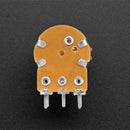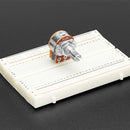Description
This potentiometer is a two-in-one: it's a log taper 10K ohm potentiometer, with a grippy shaft and it comes with an on-off switch. It's smooth and easy to turn, but not so loose that it will shift on its own. We like this one because the legs are 0.2" apart with pin-points, so you can plug it into a perfboard. Note the spacing on the switch/pot pins is 0.2" so it wont work in a solderless breadboard as nicely, unless you bend the switch pins out of the way. Once you're done prototyping, you can drill a hole into your project box and mount the potentiometer that way.
Potentiometers, or "pots" to electronics enthusiasts, are differentiated by how quickly their resistance changes. In linear pots, the amount of resistance changes in a direct pattern. If you turn or slide it halfway, its resistance will be halfway between its minimum and maximum settings. That's ideal for controlling lights or a fan, but not necessarily for audio controls.
Volume controls have to cater to the human ear, which isn't linear. Instead, logarithmic pots like this one increase their resistance on a curve. At the halfway point volume will still be moderate, but it will increase sharply as you keep turning up the volume. This corresponds to how the human ear hears. Using a log pot therefore gives the effect that a setting of full volume on the control sounds twice as loud as a setting of half volume. A linear pot used as a volume control would give large apparent changes in loudness at low volume settings, with little apparent change over the rest of the control's range.
The built-in switch makes it perfect for audio projects where you want to control both power and volume of a monophonic signal.
TECHNICAL DETAILS
10K ohm potentiometer, log taper
100,000 Cycle Life
16mm Body
Rotational travel: 300°
Static Stop Strength: 90 oz-in
Rotational Torque: 0.5 to 1.25 oz-in
Product Dimensions: 26.0mm x 25.0mm x 17.5mm / 1.0" x 1.0" x 0.7"
Product Weight: 7.8g / 0.3oz
Potentiometers, or "pots" to electronics enthusiasts, are differentiated by how quickly their resistance changes. In linear pots, the amount of resistance changes in a direct pattern. If you turn or slide it halfway, its resistance will be halfway between its minimum and maximum settings. That's ideal for controlling lights or a fan, but not necessarily for audio controls.
Volume controls have to cater to the human ear, which isn't linear. Instead, logarithmic pots like this one increase their resistance on a curve. At the halfway point volume will still be moderate, but it will increase sharply as you keep turning up the volume. This corresponds to how the human ear hears. Using a log pot therefore gives the effect that a setting of full volume on the control sounds twice as loud as a setting of half volume. A linear pot used as a volume control would give large apparent changes in loudness at low volume settings, with little apparent change over the rest of the control's range.
The built-in switch makes it perfect for audio projects where you want to control both power and volume of a monophonic signal.
TECHNICAL DETAILS
10K ohm potentiometer, log taper
100,000 Cycle Life
16mm Body
Rotational travel: 300°
Static Stop Strength: 90 oz-in
Rotational Torque: 0.5 to 1.25 oz-in
Product Dimensions: 26.0mm x 25.0mm x 17.5mm / 1.0" x 1.0" x 0.7"
Product Weight: 7.8g / 0.3oz
Payment & Security
Your payment information is processed securely. We do not store credit card details nor have access to your credit card information.








